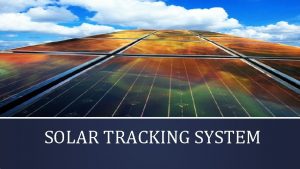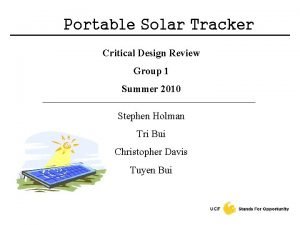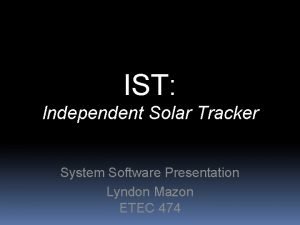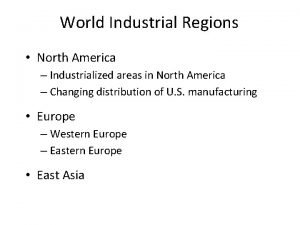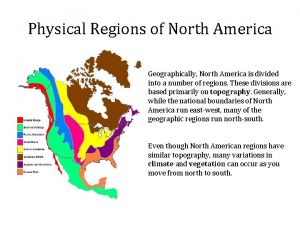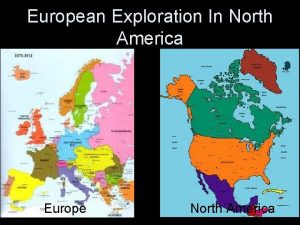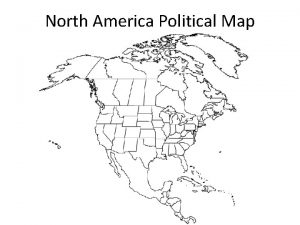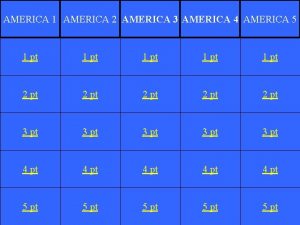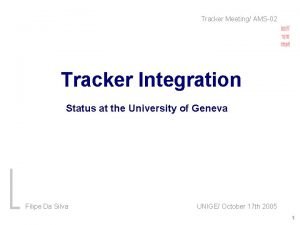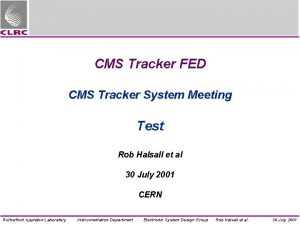North America Solar Market Tracker Q 1 2017




















- Slides: 20

North America Solar Market Tracker / Q 1 2017 Writing Sample by Martin Thomas Executive Summary © 2017 IHS 1

North America Solar Market Tracker / Q 1 2017 Changes to North American PV installation forecast The forecast for PV installations from 2016 to 2020 in this edition shows an increase of only 20 MWdc from that of the previous edition; the reasons for the increase include stronger utilityscale installation forecasts from 2016 to 2017 paired with a weaker outlook for residential and commercial solar from 2018 to 2020. • IHS has increased its forecast for 2016 by over 900 MW to account for utility-scale installations that exceeded previous IHS projections, particularly in US state markets such as California, North Carolina, and Utah. • IHS has reduced its forecast from 2018 to 2020 by over 1 GW to account for a weaker outlook for both distributed and utility-scale PV in the United States. Projected near-term underperformance in California and New York has led IHS to lower its outlook for residential and commercial PV, while predicted weaknesses in Colorado, Montana, and Utah are the primary drivers of utility-scale reductions. North America – Comparison of PV installation forecasts between current and previous editions of this update 20 000 18 000 MWdc 16 000 14 000 12 000 10 000 8 000 6 000 4 000 2 000 0 2015 Source: IHS © 2017 IHS 2016 Previous forecast 2017 2018 2019 New forecast 2020 © 2017 IHS 2

North America Solar Market Tracker / Q 1 2017 Major developments since Q 4 2016 Country Development United States § Lower-tier residential installers gained market share • Tier 1 installers such as Solar. City (Tesla) and Vivint in the US market in 2016. Solar struggled to maintain growth in the light of market slowdowns and stiffer competition from local and regional installers. Leading national residential installer Sungevity announced bankruptcy in March 2017. • The proposals highlight a positive trend that US state § Several states, including Nevada, New Mexico, governments will continue to play a large role in Massachusetts, California, and Minnesota, renewable energy deployment regardless of actions proposed increasing RPS goals. taken at the federal level of government. • The decision results in lower economic returns for new § Arizona regulators and utilities voted to end retail solar customers, which is likely ultimately to lead to net metering. market decline for distributed residential and commercial solar in Arizona. § Massachusetts regulators introduced a next • The market will move from SREC-based incentives to an generation incentive as a successor to the SREC energy value k. Wh added incentive. Once implemented, program. the new policy is expected to promote PV stability in the market. • The order moves New York closer to changing from § New York regulators approved the final order to simple net metering to more complex mechanisms, move from net metering with new compensation which are expected to add locational and time-based mechanisms. values. The residential policy will change in 2020, while the commercial policy will begin changing in 2017. Source: IHS © 2017 IHS Impact on market © 2017 IHS 3

North America Solar Market Tracker / Q 1 2017 Major developments since Q 4 2016 Country Development Impact on market Canada § The 2016 Fi. T 5 program received over 1, 000 applications accounting for nearly 400 MW of capacity. • Applications exceeded the program target by over 260%, meaning the program is likely to achieve its goal for the year. Solar PV accounted for over 90% of approved capacity. § IESO opened the 2017 micro. Fi. T program in January. • Those behind the micro. Fi. T program in Ontario will be attempting to meet program targets for 2017 after a disappointing year in 2016. Early 2017 results are indicating improvement from the previous year. § Alberta announced a new rebate program for residential and commercial. • Alberta’s new rebate program seeks to decrease residential and commercial PV costs by up to 30% by 2019. The introduction of the rebate is likely to spur greater demand for residential and commercial PV in the market. § The province of New Brunswick announced interest • Though the request is in its early staged, it is an example in procuring 40 MW of renewable energy by 2020. of the growing interest of renewable energy deployment outside of Ontario. The request is open to several technologies, including solar PV. Source: IHS © 2017 IHS 4

North America Solar Market Tracker / Q 1 2017 The West will continue to lead North America, but growth will be strongest in the Southeast and Midwest The Southeastern market will be the second largest sub-region from 2017 to 2021, installing 18. 5 GW during the period. • Emerging Southeastern markets such as Florida and Georgia are forecast to grow rapidly during the period as utilities seek to deployment cost competitive PV. The Southeastern market is forecast to grow at a 10. 9% CAGR from 2016 to 2021. North America - PV installation forecast by sub-region 20 000 18 000 16 000 MWdc The Western market will remain the largest for sub-regional PV in North America from 2017 to 2021, primarily due to the continued dominance of the California. • IHS forecasts this market to install over 27 GW during the period, comprising 35% of total installations during the time period. Though it will continue to be the largest region in North America, installations in the Western market are forecast to contract at a -10% CAGR from 2016 to 2021. 14 000 12 000 10 000 8 000 6 000 4 000 2 000 0 2015 Western USA Southwestern USA Source: IHS 2016 2017 2018 Southeastern USA Midwestern USA 2019 2020 2021 Northeastern USA Canada © 2017 IHS The Northeastern market is forecast to install over 12 GW from 2017 to 2021, driven by demand for distributed PV. • Growth will continue through 2020, but with the ITC losing value and continued state-level policy changes, installations will decline in 2021. The Southwestern market is forecast to install over 11 GW from 2017 to 2021, primarily driven by emerging demand in Texas. The Midwestern market is forecast to experience the highest growth rate of the US sub-regional markets at a 24% CAGR over the forecast period, though it will still remain the smallest sub-region throughout that time. © 2017 IHS 5

North America Solar Market Tracker / Q 1 2017 High penetration of distributed PV is leading to policy changes in key markets in the United States • Both markets have experienced significant net metering and rate design policy reform as a result. Several key distributed markets, such as Massachusetts, New Jersey, and Arizona are rapidly approaching 3% penetration of distributed PV generation • In particular, high penetration levels are prompting regulators and utilities in Arizona and Massachusetts to revise policy mechanisms From 2017 to 2021, IHS forecasts 14 markets will reach distributed PV penetration levels at or above 3%, which will likely result in policy changes that will slow customer-sited PV adoption in such markets. Distributed PV generation penetration by US state (systems <1 MW) 13% 12% 11% Distributed PV penetration (%) Hawaii and California, the markets in the United States with the highest PV penetration, reached approximately 9% and 4% penetration of distributed PV respectively in terms of retail generation sales by the end of 2016. 10% 9% 8% 7% 6% Penetration above 3% is relatively high, likely to drive policy changes. 5% 4% 3% 2% 1% 0% 2016 Hawaii California Vermont Massachusetts New Jersey Arizona Connecticut Maryland Utah New Mexico Source: IHS Solar Market Tracker - North America © 2017 IHS 2021 © 2017 IHS 6

North America Solar Market Tracker / Q 1 2017 Revenues for the North American PV market from 2017 to 2021 will total over $100 billion IHS forecasts that PV market revenues in North America from 2017 to 2021 will total $112 billion, with the United States accounting for over $100 billion. North American PV market revenue 2017 - 2021 (billions) • Revenues are forecast to be driven by investments in the utility-scale segment, which represents 43% of the total market value during the period. Utility-scale PV investment is forecast to grow at a CAGR of 8. 1%. $ 49 $112 billion • Annual revenues are forecast to peak in 2019 at $25 billion as utility-scale and residential in the United States experiences significant growth. $ 38 Residential Commercial Utility-scale $ 26 Source: IHS © 2017 IHS Annual PV market value - North America ($US millions) Revenues ($US millions) 30 000 25 000 20 000 15 000 10 000 5 000 0 2017 Source: IHS © 2017 IHS 2018 United States 2019 2020 Canada 2021 © 2017 IHS 7

North America Solar Market Tracker / Q 1 2017 Country profile – United States By 2017, PV will be grid-competitive in over 40 states U. S. state markets where solar PV is cheaper than the grid Chart Titleby market segment 1, 80 43 45 43 41 45 43 38 40 45 43 39 1, 60 35 30 24 25 20 1, 50 28 26 1, 40 18 17 1, 30 15 1, 20 10 10 1, 10 5 0 1, 00 2016 Residential PV Source: IHS 1, 70 Installation costs ($/W) Number of state markets 50 2017 Commercial PV 2018 2019 Utility-scale PV 2020 2021 Average PV installation cost ($/W) © 2017 IHS • As the cost to install PV continues to fall in the United States, the long-term levelized cost of PV, with the support of the federal ITC, is expected to become lower than the levelized cost of prevailing retail and wholesale electricity rates throughout the country. In 2017, utility-scale PV is projected to become increasingly attractive throughout the Southwest, Southeast, and Midwest because of wholesale power price projections. The number of states with at least one attractive market segment is forecast to peak at 47 during the period. © 2017 IHS 8

North America Solar Market Tracker / Q 1 2017 California to account for lower share of demand from 2017 to 2021 as emerging markets continue to grow North America - top states in 2017 12 GWdc North America - top states 2018 -2021 California Texas North Carolina Florida Nevada New York 66 GWdc Florida Georgia Maryland Georgia North Carolina Nevada Arizona Virginia Minnesota Massachusetts Others Source: IHS Arizona Others © 2017 IHS Source: IHS © 2017 IHS forecasts that North America will install 12. 4 GWdc in 2017, with 56% accounted for by PV capacity under development in the top five markets • Year over year, the North American solar market is forecast to decline by 22% in 2017, driven by lower demand for utility-scale PV in the United States after the project development pipeline resets to prepare for increased demand from 2019. • US states are projected to account for the top 10 markets in North America in 2017, with the top five projected to install over half of PV capacity during the year, primarily due to utility-scale demand in markets such as California, Texas, and North Carolina. From 2018 and 2021, California will become less prominent in North America as growth diversifies into emerging markets • California will continue to be the top state market for distributed and utility-scale PV, but it will account less than 25% of installed capacity during the period. • Growth will primarily be driven in emerging distributed markets such as New York along with strong utility-scale growth in Texas, Florida, Georgia, and Virginia. © 2017 IHS 9

North America Solar Market Tracker / Q 1 2017 Regional markets – United States © 2017 IHS 10

United States North America Solar Market Tracker / Q 1 2017 United States regional profile – The West USA - West - annual PV installations 9 000 8 000 7 000 MWdc 6 000 5 000 4 000 IHS forecasts that the Western United States will install nearly 27 GW of PV from 2017 to 2021 • • • High solar irradiation rates, land availability, supportive statelevel policies, and moderate-to-high retail rates for electricity in key markets are the primary drivers for PV adoption in the region. In the sub-region, IHS predicts the utility-scale segment will account for the largest proportion, 57%, of PV capacity additions over the forecast period. Annual demand for utility-scale PV is forecast to remain relatively flat during the period in the Western region, whereas demand for distributed residential and commercial PV is forecast to peak in 2019 before declining in 2020 and 2021 due to the impact of projected policy changes. © 2017 IHS 3 000 2 000 1 000 0 Utility-Scale Commercial Residential Source: IHS 2015 2 648 765 1 158 2016 6 238 849 1 193 2017 3 045 1 004 1 273 2018 2 606 1 046 1 525 2019 3 190 1 201 1 937 2020 3 564 1 013 1 072 2021 3 289 738 875 © 2017 IHS 11

United States North America Solar Market Tracker / Q 1 2017 United States regional profile – The Western market is primarily driven by demand in California USA - West - annual PV installations 9 000 • From 2017 to 2021, California is forecast to install nearly 8 000 19 GW of PV, accounting for 69% pf demand in the subregion during the period. 7 000 Most states in the Western market will see decline after having experienced significant booms in recent years Utah are forecast to experience decline from 2016 to 2021. Primary drivers of PV demand in the Western market include RPS programs, net metering, PURPA, and cost competitive procurement of utility-scale PV. MWdc • Leading Western markets such as California, Nevada, and 6 000 5 000 4 000 3 000 2 000 1 000 0 State-mandated renewable policies in the West State California Policy Colorado RPS mandate Hawaii RPS mandate 100% – 2045 Montana RPS mandate 15% – 2015 Nevada RPS mandate 25% – 2025 • Oregon RPS mandate 50% – 2040 Washington RPS mandate 15% – 2020 Utah Voluntary goal 20% – 2025 Source: IHS © 2017 IHS RPS mandate Target Solar/DG requirement 50% – 2030 30% – 2020 • 3% DG requirement 1. 5% solar requirement Alaska Wyoming Montana Washington Hawaii Idaho Oregon Colorado Utah Nevada California Source: IHS 2015 0 0 1 26 116 3 29 215 198 658 3 324 2016 0 1 27 29 168 301 161 357 1 116 831 5 289 2017 0 1 77 33 103 66 138 269 665 3 804 2018 0 1 40 67 75 138 172 244 280 339 3 820 2019 0 21 24 106 99 147 196 283 498 504 4 451 2020 0 32 25 114 106 155 230 325 522 653 3 489 2021 0 32 15 96 112 163 232 322 208 336 3 387 © 2017 IHS 12

United States North America Solar Market Tracker / Q 1 2017 United States regional profile – The Northeast USA - Northeast - annual PV installations 3 500 3 000 MWdc 2 500 2 000 1 500 IHS predicts the Northeast will be the only sub-regional market that will grow in 2017; IHS forecasts that the sub-region will install 12. 3 GW of PV from 2017 to 2021. • Most markets in the region have historically promoted non-utility PV by offering retail net metering and incentives targeted at residential and commercial systems. Higher retail electricity rates make net metering a particularly strong incentive for solar. • The market in the Northeast is primarily driven by distributed residential and commercial PV installations. The region is forecast to install 9. 9 GW of PV from the two segments, or 80% of demand, during the period. • Annual demand for residential and commercial PV is forecast to peak in 2020 before declining in 2021 as policy changes slow growth and the lower ITC values affect projected economics. © 2017 IHS 1 000 500 0 Utility-Scale Commercial Residential Source: IHS 2015 113 645 384 2016 286 891 557 2017 414 928 682 2018 397 1 073 813 2019 486 1 240 937 2020 563 1 327 1 024 2021 574 1 082 748 © 2017 IHS 13

United States North America Solar Market Tracker / Q 1 2017 United States regional profile – The Northeast USA - Northeast - annual PV installations 3 500 3 000 2 500 2 000 MWdc The Northeastern PV market is forecast to be primarily driven by four states: New York, Massachusetts, Maryland, and New Jersey. • From 2017 to 2021, the four markets are forecast to install over 9 GW of PV, accounting for 74% of installed capacity in the sub-region. New York will be the largest and fastest-growing market. • New York is forecast to grow at a 20% CAGR from 2016 to 2021, while Massachusetts and New Jersey are forecast to contract at 6. 8% and 5. 3% CAGRs, respectively. Primary drivers in the Northeast include RPS programs, SRECs, net metering, and community solar. 1 500 1 000 500 0 State-mandated renewable policies in the Northeast State Connecticut Policy Target RPS mandate 27% – 2020 Delaware RPS mandate 25% – 2026 • 3. 5% solar requirement District of Columbia RPS mandate 50% – 2032 • 5% solar by 2032 Maine RPS mandate 40% – 2017 Maryland RPS mandate 20% – 2022 • 2% solar by 2020 Massachusetts RPS mandate 15% – 2020 • 1, 600 MW in-state solar New Hampshire RPS mandate 24. 8% – 2025 New Jersey RPS mandate 24. 4% – 2028 • New York RPS mandate 50% – 2030 Pennsylvania RPS mandate Rhode Island RPS mandate Vermont RPS mandate Source: IHS © 2017 IHS Solar/DG requirement 18% – 2021 • 4. 1% solar requirement 2015 4 11 7 7 45 17 17 92 192 204 323 2016 11 23 12 14 49 23 38 121 341 317 468 317 2017 13 34 26 64 47 35 60 152 316 404 365 508 2018 15 40 51 69 50 47 110 176 331 356 397 641 2019 19 49 49 45 81 89 145 205 365 408 435 774 2020 20 63 67 48 105 90 151 227 381 477 461 822 2021 14 65 83 51 60 98 172 260 310 330 785 0. 5% solar requirement 14. 5% – 2019 75% – 2032 • District of Columbia Delaware Rhode Island Maine Vermont New Hampshire Pennsylvania Connecticut New Jersey Maryland Massachusetts New York 10% DG requirement Source: IHS © 2017 IHS 14

United States North America Solar Market Tracker / Q 1 2017 United States regional profile – The Southeast USA - Southeast - annual PV installations 6 000 5 000 MWdc 4 000 3 000 2 000 IHS forecasts that the Southeastern United States will install 18. 5 GW of PV from 2017 to 2021 • Large procurement programs directed by utilities are driving demand for utility-scale PV in the sub-region, along with demand generated by PURPA mechanisms in select markets. Low retail rates for electricity are keeping demand for net metered residential and commercial PV relatively low. • The Southeast is forecast to install over 16 GW of utility-scale PV from 2017 to 2021, accounting for 87% of demand in the sub -region. • The sub-region is forecast to experience growth from 2017 through 2021 as utilities seek to deploy cost competitive utilityscale PV while the federal ITC incentive remains relatively valuable. © 2017 IHS 1 000 0 Utility-Scale Commercial Residential Source: IHS 2015 1 521 187 63 2016 2 577 214 101 2017 2 284 211 123 2018 2 448 215 159 2019 3 253 219 2020 3 896 313 294 2021 4 265 303 272 © 2017 IHS 15

United States North America Solar Market Tracker / Q 1 2017 United States regional profile – The Southeast State mandated renewable policies in the Southeast State Policy North Carolina RPS mandate South Carolina Voluntary goal Virginia Voluntary goal Source: IHS © 2017 IHS Target Solar/DG requirement 12. 5% – 2021 • 2% – 2021 • USA - Southeast - annual PV installations 6 000 5 000 4 000 3 000 MWdc Growth in the Southeastern market will primarily be driven by demand for utility-scale PV in Florida • From 2017 to 2021, Florida is forecast to install over 5 GW of PV, accounting for 27% of demand in the sub-region during the period. Overall, the Southeastern PV market is forecast to grow at an 11% CAGR from 2016 to 2021. • Key markets include Florida, Virginia, and South Carolina, with each forecast to grow at CAGRs between 17% and 26% during the period. Primary drivers for the Southeastern market include utility-scale procurement programs and PURPA • Large utilities such as Duke Energy, Georgia Power, and Florida Power & Light are driving demand for utility-scale PV through cost competitive, voluntary procurement mechanisms. • PURPA has historically driven demand in markets such as North Carolina by providing long-term, utility avoided cost contract opportunities for qualifying facilities. • The Southeast is notably the sub-region least driven by renewable energy policy mandates such as RPS programs. 2 000 1 000 0 West Virginia Kentucky Louisiana Arkansas Tennessee Mississippi Alabama South Carolina Virginia Georgia North Carolina Florida 2015 1 1 38 16 6 3 0 7 10 347 1 300 42 2016 21 18 22 2 26 3 125 133 203 792 1 113 434 2017 22 20 12 4 57 134 43 149 298 452 956 472 2018 13 36 59 136 123 116 147 197 346 434 472 744 2019 24 83 111 139 160 156 191 290 423 558 497 1 093 2020 36 155 165 143 191 187 221 366 500 683 546 1 311 2021 36 159 213 146 210 198 265 289 539 736 658 1 391 0. 2% solar by 2018 Systems <10 MW 15% – 2025 Source: IHS © 2017 IHS 16

United States North America Solar Market Tracker / Q 1 2017 United States regional profile – The Southwest USA - Southwest - annual PV installations 3 000 2 500 MWdc 2 000 IHS forecasts that the Southwestern United States will install 11 GW of PV from 2017 and 2021 • Like the Western sub-region, the Southwest is characterized by relatively high levels of solar irradiation and abundant land for developing large-scale renewables. • The Southwestern market is primarily driven by demand for utilityscale PV, which is forecast to account for 9 GW or 81% of installed capacity from 2017 to 2021 in the sub-region. • Demand for commercial PV is relatively low due to the low power prices available to most commercial and industrial customers in the region. • Annual demand for PV is forecast to grow from 2017 through 2021 due to a mix of renewable policy goals and growing demand for cost competitive utility-scale PV. © 2017 IHS 1 500 1 000 500 0 Utility-Scale Commercial Residential Source: IHS 2015 380 133 149 2016 1 398 147 225 2017 1 077 139 252 2018 1 301 124 225 2019 1 948 138 270 2020 2 281 158 343 2021 2 360 154 320 © 2017 IHS 17

United States North America Solar Market Tracker / Q 1 2017 United States regional profile – The Southwest Growth in the Southwestern market will primarily be driven demand for utility-scale PV in Texas and Arizona USA - Southwest - annual PV installations 3 000 • From 2017 to 2021, Texas and Arizona collectively are 2 500 forecast to install over 9 GW of PV, accounting for 85% of demand in the Southwest. • Texas is forecast to be the second-largest market in the United States during the period. 1 500 MWdc Overall, the Southeastern PV market is forecast to grow at a 10% CAGR from 2016 to 2021. 2 000 1 000 • Texas is forecast to grow at a 15% CAGR during the period, while demand in historically leading market Arizona remains relatively flat. Primary drivers of PV demand in Southwest include RPS programs, net metering, and cost competitive procurement of utility-scale PV. State mandated renewable policies in the Southwest State Arizona Policy Target RPS mandate 15% – 2025 • 4. 5% DG requirement New Mexico RPS mandate 20% – 2020 • 4% solar requirement 0. 6% DG requirement Voluntary goal Texas Voluntary goal Oklahoma New Mexico Arizona Texas 5%* – 2015 • 2016 30 241 701 797 2017 9 96 387 976 2018 76 131 552 890 2019 145 204 749 1 258 2020 249 292 808 1 434 2021 252 195 811 1 576 *5% of 2001 demand 500 MW of non-wind © 2017 IHS Source: IHS © 2017 IHS 2015 0 82 321 258 15% –- 2015 • Source: IHS 0 Solar/DG requirement • Oklahoma 500 © 2017 IHS 18

United States North America Solar Market Tracker / Q 1 2017 United States regional profile – The Midwest USA - Midwest - annual PV installations 2 500 2 000 MWdc 1 500 1 000 IHS forecasts that the Midwestern United States will install over 7. 2 GW of PV from 2017 to 2021 • Demand for PV in the Midwest is forecast to be primarily driven by the utility-scale market as utilities seek to comply with varying levels of renewable energy and emission reduction goals. • Utility-scale PV is forecast to account for 5 GW or 71% of demand in the Midwest from 2017 to 2021. • Commercial demand will be primarily driven by opportunities for community solar in the near-term, while residential PV is forecast to experience growth through 2021 due to supportive policies and relatively low saturation. • Annual demand for PV is forecast to grow from 2017 through 2021 as the utility-scale market grows at a 59% CAGR. © 2017 IHS 500 0 Utility-Scale Commercial Residential Source: IHS 2015 32 63 30 2016 487 256 40 2017 284 355 53 2018 515 267 76 2019 985 260 111 2020 1 480 306 158 2021 1 808 321 183 © 2017 IHS 19

United States North America Solar Market Tracker / Q 1 2017 United States regional profile – The Midwest State mandated renewable policies in the Midwest State Illinois Policy Target Solar/DG requirement RPS mandate 25% – 2026 • • 1. 5% solar requirement 0. 25% DG requirement Iowa RPS mandate 105 MW Michigan RPS mandate 15% – 2021 Minnesota RPS mandate ~27% – 2025 • Missouri RPS mandate 15% – 2021 • 0. 3% solar requirement Ohio RPS mandate 12. 5% – 2026 • 0. 5% solar requirement Wisconsin RPS mandate 10% – 2015 Indiana Voluntary goal 10% – 2025 Kansas Voluntary goal 20% – 2020 North Dakota Voluntary goal 10% – 2015 Source: IHS © 2017 IHS 1. 5% solar by 2020 USA - Midwest - annual PV installations 2 500 2 000 1 500 MWdc While growth is forecast to be more diverse throughout markets in the Midwest, the outlooks Minnesota, Indiana, and Missouri look particularly strong for utility-scale PV. • From 2017 to 2021, these three states combined are forecast to install 3. 2 GW of PV, accounting for 45% of demand in the Midwest. Overall, the Midwestern PV market is forecast to grow at a 24% CAGR from 2016 to 2021. • While demand in Minnesota, the leading market in the sub-region, is forecast to remain relatively flat during the period, IHS forecasts growth between CAGRs of 32% and 63% for Indiana and Minnesota due to projected demand for cost competitive utilityscale PV. Primary drivers of PV demand in the Midwest include RPS programs, net metering, and cost competitive procurement of utility-scale PV. 1 000 500 0 North Dakota South Dakota Nebraska Illinois Wisconsin Iowa Kansas Ohio Michigan Missouri Indiana Minnesota Source: IHS 2015 0 0 0 8 0 0 2 2 5 4 35 5 2016 0 0 13 21 25 9 0 3 75 6 70 475 2017 0 0 4 25 20 15 26 31 44 12 54 355 2018 0 0 5 49 40 56 51 13 73 28 72 332 2019 0 0 60 68 76 83 102 69 140 110 160 300 2020 0 0 75 73 128 129 153 136 150 261 233 356 2021 0 0 80 77 140 135 153 269 214 261 293 412 © 2017 IHS 20
 North america south america europe asia
North america south america europe asia Us secondary wood products market
Us secondary wood products market Solar tracker circuit diagram
Solar tracker circuit diagram Portable solar tracker
Portable solar tracker Wholesale solar module
Wholesale solar module Independent solar tracker
Independent solar tracker Leader follower challenger nicher
Leader follower challenger nicher Difference between segmentation targeting and positioning
Difference between segmentation targeting and positioning Solar energy is free. solar is inexhaustible
Solar energy is free. solar is inexhaustible America america you mean the world to me
America america you mean the world to me Whats an onomatopeia
Whats an onomatopeia Why is it called latin america
Why is it called latin america Eu amo a américa e a américa me ama
Eu amo a américa e a américa me ama Industrialized regions
Industrialized regions Why are cold fronts steeper than warm fronts
Why are cold fronts steeper than warm fronts French and indian war
French and indian war Vegetation of north america
Vegetation of north america Physiographic regions of north america
Physiographic regions of north america Ottawa in north america map
Ottawa in north america map Yucatan peninsula on map of south america
Yucatan peninsula on map of south america Great plains of canada
Great plains of canada


